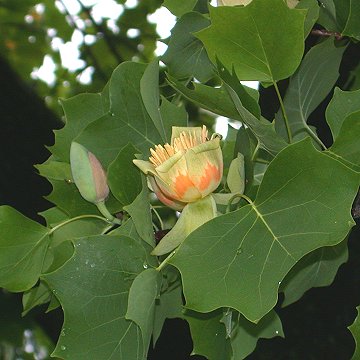

Liriodendron tulipifera - (image 1 of 7)
Taxonomy
Family: Magnoliaceae
Habitat
Eastern woodlands
Associates
Acer saccharum, Betula alleghaniensis, Cornus florida, Euonymus obovatus, Fagus grandifolia, Hamamelis virginiana, Lindera benzoin, Ribes cynosbati, Sassafras albidum, Taxus canadensis, Tilia americana, Tsuga canadensis, Ulumus americana.
Distribution
MA to WI, south to FL and MS.
Morphology
Large deciduous tree to 150', historic records of 200' specimens may be exaggerated. Leaves alternate, simple, to 8" wide and long, with a broad square apex and two small acute lobes on either side, green above, pale beneath, petiole to 4" long. Terminal bud silky pubescent, valvate, shaped like a duck bill; lateral buds similar but much smaller. Stems lustrous green to red-brown, sometimes glaucous, aromatic when scratched. Bark gray brown, smooth when young, becoming furrowed in older specimens. Flowers perfect, yellow and orange; petals 6, in two rows; sepals 3, reflexed. Fruit a cone-like aggregate of samaras, to 3" and 3/4" wide, shed in early winter.
Notes
Flowers late May to mid July.
Wetland indicator: Facultative upland+
One of the largest trees of the eastern deciduous forests. The flowers are often too high on the trees to appreciate but they are very beautiful. The fall color is usually a good yellow.
Bibliography
Dirr, Michael A. 1998. Manual of Woody Landscape Plants:
Their Identification, Ornamental Characteristics, Culture, Propagation and Uses.
5th ed. Champaign, Illinois: Stipes Publishing L.L.C.
Farrar, J. L. 1995. Trees of the Northern United States and Canada.
Ames, Iowa: Iowa State University Press
Swink, F. and G. Wilhelm. 1994. Plants of the Chicago Region.
Indiana Academy of Science. The Morton Arboretum. Lisle, Illinois.
|
Michael Hough © 2005 |